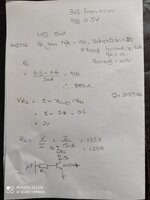Rajinder1268
Full Member level 3
Hi,
I am driving a blue LED from a PIC GPIO.
The transistor is 2N3904, LED is worth elektonik 151033bs0300. The supply for the LED is 5V, I am driving it at 15mA.
I have attached my calculations. Do they look correct?
Do I need a pull down at the base of Q1 to ensure the transistor is off and we don't get the LED to light on switch on.
Thanks
I am driving a blue LED from a PIC GPIO.
The transistor is 2N3904, LED is worth elektonik 151033bs0300. The supply for the LED is 5V, I am driving it at 15mA.
I have attached my calculations. Do they look correct?
Do I need a pull down at the base of Q1 to ensure the transistor is off and we don't get the LED to light on switch on.
Thanks
